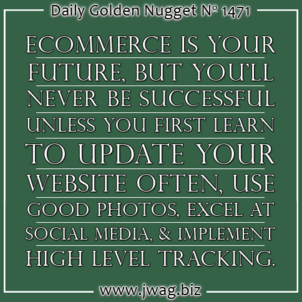 It seems like only yesterday when it was thought that email addresses would become more important than telephone numbers, and now a website address is more important than both a telephone number and a physical address. A website is the most important representation of your business, yet most jewelers don't treat it that way, and many still view it as an online brochure that needs to be made once, and then forgotten about.
It seems like only yesterday when it was thought that email addresses would become more important than telephone numbers, and now a website address is more important than both a telephone number and a physical address. A website is the most important representation of your business, yet most jewelers don't treat it that way, and many still view it as an online brochure that needs to be made once, and then forgotten about.The local retail jeweler is losing a lot of business to the internet. The younger generation of jewelry designers, who grew up with the internet, are building ecommerce websites and selling directly. Meanwhile, there are plenty of jewelry manufacturers who are being forced to sell online because sales to retail stores are down. With social media like Pinterest and Instagram driving interest, the demand for jewelry isn't shrinking, but sales are being funneled through more jewelry e-commerce websites. At least once a week, I hear about a new jewelry e-commerce website that expects to capture a few million in sales within their first year of launch, that potential money would be redirected from the pockets of the current population of retail jewelry stores. Trends indicate that every retail jewelry store will eventually need to have some type of e-commerce website and build an audience far outside their local area.
However, I don't think it's realistic to tell you that you need to jump from your current website into e-commerce without first understanding some simple ways to improve your current website habits. We all need to walk before we learn to run, and so I've written out the following 4 ways you can better walk with your current site while you plan for the inevitability of e-commerce.
Update Your Website Frequently
I can't stress this point enough. Your website should be updated every time you have a new event, new promotion, or add a new product line to your store. It's early March 2016 as I write this, and I know of a few retail jeweler websites that still have promotions for Black Friday, back in November 2015, on their home page, while others still have Valentine's Day promotions posted from last month. At minimum, you should update your home page once a month, but your target habit should be to update it once a week. By the time you get to e-commerce, you'll be updating it every day.
Learn to Achieve the Wow
Jewelry photography is tough, but everyone can eventually learn to do it when you have the right equipment. Most jewelry websites have large photos or ads on their home page that are simply not effective marketing tools. Your home page needs to command attention as soon as someone sees it, yet general photography on white backgrounds will never do that. Unusual angles, extreme close-ups, and colorful backgrounds are among the better ways to "wow" someone seeing it. The cost of professional photography is very expensive, and often seems like an impossible barrier to entry into e-commerce, yet it's not impossible at all. I've written a lot of information about jewelry photography, and presented several seminars on the topic. If you happen to be at the MJSA Expo in NYC today (March 14, 2015), please stop by MJSA booth 540 and I'll have an in person conversation about photography.
Become a Social Maven
There's a new generation of jewelry designers that grew up with the internet. For them, it's easy to share photos on Instagram and pin to Pinterest and attract thousands of followers from all over the world. They've managed to attract an audience for their single line of jewelry, but a retail jeweler has far more to share. Many retail jewelers are paying $250 or more per month to a social media marketing agency just to maintain a social presence. However, that activity isn't specific enough to generate strong sales. For ecommerce to be successful, someone in your store needs to learn to manage your social media accounts and build a following by engaging customers online. Eventually, you'll need a social media director on your staff.
Learn to Marry Your Marketing Together
You have to learn to tie all your marketing together and track it all. Even though it's easy to track the results from online advertising, most retail jewelers are paying for online marketing without implementing ways to track the results. While we might be in a digital age, print certainly isn't dead, and I'm not only talking about your local newspaper either. Find other local places to advertise where your customers frequent. It could be as simple as a shopping cart ad at a grocery store, or a full page ad in the program at the local center for performing arts. Don't give up on print media; just ask your marketing agency for innovative ways to track it. Your future ecommerce website will live or die based on the how you measure results, which in turn guide your marketing spending.
Right now, every time a retail jeweler asks me to set up an ecommerce website for them I try to talk them out of it. Although I'd love to build an ecommerce website for everyone who hires me, I also know that most are not yet prepared for the required level of commitment to achieve success. Ecommerce is your future, like it or not, but you'll never get there without the mastery of the above four items.








